Hyundai
Elantra Rear Brake Pads Replacement Guide
How to replace the rear disc brake pads
on a 5th generation (2011 to 2016) Hyundai Elantra sedan with pictures.
By Paul B. Michaels Author & Photographer Auto Mechanic Since 1989 |
||
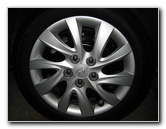 Elantra Rear Wheel |
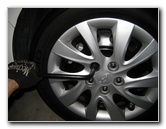 Loosen Rear Lug Nuts |
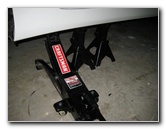 Raise Vehicle - Floor Jack |
| This
automotive maintenance "how-to" guide was specifically written to
assist owners of the 5th generation 2011, 2012 & 2013 Hyundai Elantra in replacing the
rear disc brake pads. Owners of other Hyundai or Kia vehicles such as the Accent, Sonata, Azera, Veloster, Tucson, Santa Fe, Veracruz, Genesis, Forte, Optima, Rio, Soul, Sorento, Sportage, i10, i20, i30, i35, i40, Tiburon, Avante and Sedona may also find these DIY instructions to be helpful. The tools needed to complete this rear brake job include a floor jack, jack stands, a tire iron or lug nut wrench, a 14mm socket with ratcheting wrench, a Lisle 28600 disc brake piston tool. Some compatible rear brake pads include the following with their part numbers: Wagner QC1544, ACDelco 14D1544CH, KFE KFE1544-104, TRW TPC1544, Bosch BE1544H, Wagner ZD1544, Bosch BP1544, Hyundai 58302-3XA30, and the Raybestos PGD1544C. |
||
|
|
||
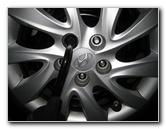 Remove 5 Lug Nuts |
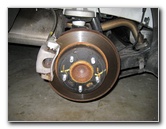 Rear Brake Rotor & Bracket |
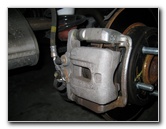 Rear Brake Caliper |
| The first few steps
are to make sure the vehicle's transmission is in "Park", chock the front
wheels, and slightly loosen the lug nuts on the rear wheels with a tire
iron. Then raise the rear of the vehicle with a floor jack and securely support it with two jack stands. Spin off the five lug nuts and remove the rear wheel to reveal the rear brake caliper, bracket and rotor. |
||
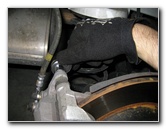 Loosen 14mm Caliper Bolt |
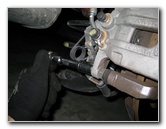 Loosen Lower Caliper Bolt |
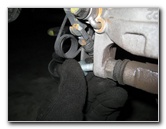 Remove Lower Caliper Bolt |
| Use a 14mm socket and ratcheting wrench to loosen the two caliper bolts located on the rear of the brake caliper by turning them clockwise (to the right) as seen from the outside of the vehicle. | ||
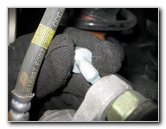 Remove Upper Caliper Bolt |
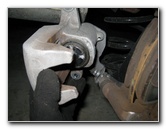 Pull Off Rear Brake Caliper |
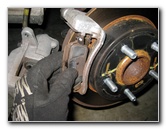 Remove Rear Brake Pads |
| Remove the two
caliper bolts and carefully lift the caliper out of the brake caliper
bracket. Rest the rear caliper on the suspension without stressing the
rubber brake fluid lines. Pull the old brake pads out of the caliper bracket and make a mental note of where the wear or "squeal" bar is located. On this 2011 Elantra GLS, the wear bar was situated at the bottom of the inner brake pad. I recommend buying the Wagner ThermoQuiet QC1544 brake pads since they have excellent reviews on Amazon. |
||
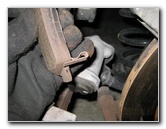 Wear Bar Bottom Inner Pad |
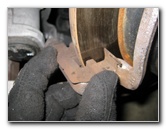 Replace Anti-Rattle Clips |
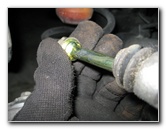 Remove Caliper Slider Pins |
| If your set of new
pads came with new anti-rattle or "abutment" clips, pull out the old ones
from the caliper bracket and install the new ones in their place.
Remove the brake caliper slider pins from their rubber dust boots to make sure that they are well lubricated. If they appear dry, apply a generous amount of a high pressure / temperature silicone based lubricant or brake caliper grease. Re-insert the lubricated caliper slider pins into the bracket and push until their rubber dust boots pop back into place. |
||
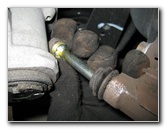 Inspect & Lubricate Pins |
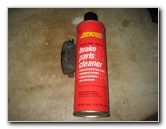 Brake Parts Cleaner Spray |
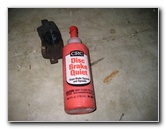 CRC Disc Brake Quiet Gel |
|
Thoroughly clean off the rotor, caliper body, caliper piston and caliper bracket with some brake parts cleaner spray. To help prevent braking noise, an optional step is to apply some CRC Disc Brake Quiet gel or any other similar product to the rear of the brake pads where they come in contact with the caliper. (Do not apply anything to the friction surface of the new pads.)
The service manual torque specification for tightening the larger bracket bolts is 51 to 63 lb-ft (or 69 to 85 N*m). |
||
|
|
||
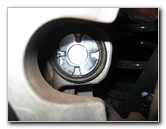 Rear Caliper Piston |
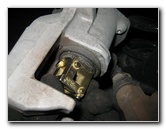 Test Fit Caliper Piston Tool |
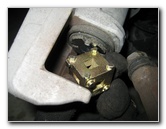 Use Side With Four Tabs |
| The '11-'13 Hyundai
Elantra is equipped with screw in type rear caliper pistons that need to be
turned back in order for the caliper to fit over the thicker new brake pads. The easiest way to turn back screw-in caliper pistons is by using a disc brake caliper piston tool such as the Lisle Disc Brake Piston Tool (part # 28600). |
||
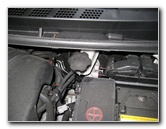 Brake Fluid Reservoir |
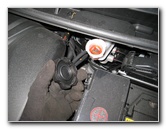 Remove Reservoir Cap |
 Turn Back Caliper Piston |
| Before you turn
back the caliper piston, move to the engine bay and twist off the brake
fluid reservoir by turning it counter clockwise. Removing the brake fluid
reservoir cap will allow the brake fluid to more easily travel backwards
through the system when you turn back the piston. Brake fluid is hygroscopic (absorbs water), so replace the brake fluid reservoir cap as soon as you are done turning back the caliper piston to prevent it from becoming contaminated. Test fit the various sides of your disc brake piston tool, such as the Lisle 28600, to find the side that has the best grip on the piston. I found that the side with the four small nubs or pegs fit the best. Attach a 3/8" drive ratcheting wrench with an extension bar to the disc brake piston tool and slowly turn back the piston in the clockwise direction until it is flush with the rubber dust boot. Repeatedly check the brake fluid level in the reservoir while turning back the caliper piston to prevent it from overflowing. |
||
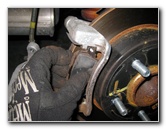 Install New Rear Brake Pads |
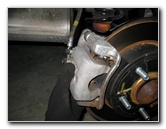 Replace Brake Caliper |
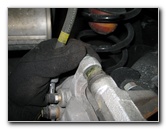 Replace Caliper Bolts |
| Slide the new rear
brake pads into the caliper bracket and push them together until they are
flush against the rotor. Be sure to install the new pads with the wear bar
located at the bottom of the inner brake pad. Gently lower the brake caliper over the new pads and down on to the rotor. If the caliper won't fit over the new brake pads, you may need to turn back the caliper piston a bit more. Line up the bolt holes in the caliper with the holes in the slider pins installed in the bracket. Replace the two 14mm caliper bolts and thread them in by hand a few turns counter clockwise (as seen from the outside of the car) to prevent them from becoming cross threaded. |
||
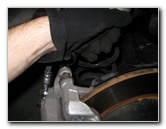 Tighten Upper Caliper Bolt |
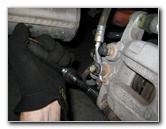 Tighten Lower 14mm Bolt |
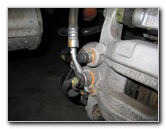 Brake Line Bleeder Valve |
| Use the 14mm socket
and ratcheting wrench to tighten the two caliper bolts to just past hand
tight or about 20 to 25 ft lbs of torque. Note - The service manual's torque specification for the rear caliper bolts is 15.9 to 23.1 lb-ft (or 21.6 to 31.4 N*m). Double check that both of the caliper bolts are snug before continuing on to the next steps. If your brake pedal previously felt soft or spongy, the brake fluid may be contaminated with moisture or the brake lines may contain air bubbles. It would be best to bleed the brake lines at this time in order to flush out the old fluid and replace it with fresh DOT3 brake fluid. For more on this topic, check out my Brake Line Fluid Bleeding With An Assistant DIY Guide or alternatively the Brake Line Fluid Bleeding With A Power Bleeder Guide. |
||
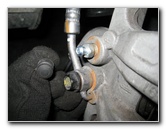 Remove Rubber Valve Cap |
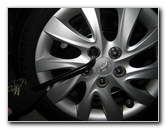 Spin On Lug Nuts |
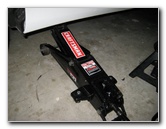 Lower Vehicle |
| Replace the wheel
and the wheel cover (hub cap) before spinning on the five lug nuts by hand
to prevent them from becoming cross threaded.
Tighten the lug nuts a bit with the tire iron and then lower the vehicle from the jack stands using the floor jack. |
||
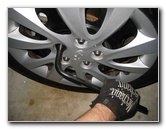 Tighten Lug Nuts |
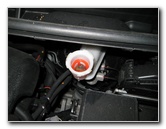 Check Brake Fluid Level |
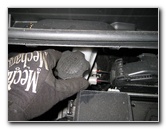 Replace Brake Fluid Cap |
| Progressively
tighten the five lug nuts in a "star" or "criss cross" pattern to just past
hand tight. It would be best to use a torque wrench or an air gun with a
torque stick to tighten the lug nuts to the owner's manual specification of
65 to 79 lb-ft (or 88 to 107 N*m).
Note - The owner's manual torque specification for tightening the the lug nuts is 65.1 to 79.6 lb-ft (or 88.3 to 107.9 N*m). Please double check the owner's manual to verify the correct lug nut torque specification for your specific vehicle and wheel type. The larger 16" and 17 inch wheels have a lug nut torque specification of 80 to 94 lb-ft (or 108 to 128 N*m). Sit in the driver's seat of the vehicle and pump the brake pedal a few times to restore the brake line pressure. Then check the brake fluid level in the reservoir and verify that it is at the "MAX" line. If it is low, pour in some new DOT 3 brake fluid. Once the brake fluid level is correct, replace the brake fluid reservoir cap by twisting it on clockwise. To properly break in your new rear brake pads, just drive normally for the first 200-300 hundred miles while trying to avoid any hard or "panic" stops which may glaze over the new brake pads and cause them to be noisy and/or not perform as well. It's also a good idea to regularly examine your driveway for drops of brake fluid which may indicate a leak, check the brake fluid level in the reservoir, and also check that the lug nuts are still properly tightened. For more, please check out my other
Hyundai Elantra Repair & Maintenance DIY Guides. |
||
| If you found this guide to be helpful,
please consider making a small donation by clicking on the PayPal.com
"Donate" button located to the right of this paragraph. Thank you!
(Note: I am not a registered charity. Donations are not tax deductible.) |

